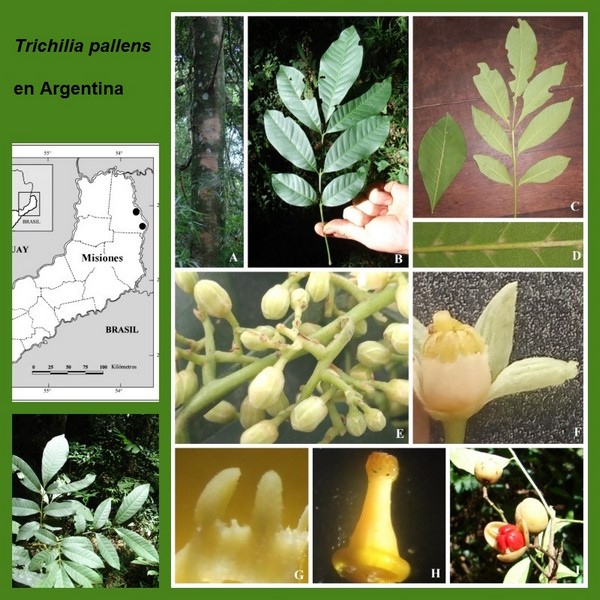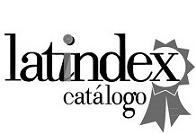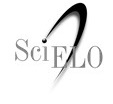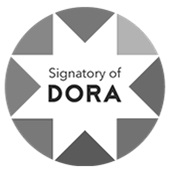Trichilia pallens (Meliaceae) new record for the argentine flora and nomenclatural novelties for the genus
DOI:
https://doi.org/10.30972/bon.3317220Keywords:
Lectotype, mixed ombrophilous forest, Sapindales, taxonomyAbstract
Trichilia is one of the most diverse genera of the family Meliaceae, currently with five
species for the argentine flora, including Trichilia pallens, which is reported for the first time. A
morphological description of the species is presented as well as field pictures, its geographic
distribution, habitat, phenology, vernacular names, uses, conservation status, diagnostic
characters, and the first key for to the species of Trichilia in Argentina. In addition, lectotypes
are designated for Trichilia brachythyrsus, T. petiolulata, T. glabriramea, and T. puberulanthera, including nomenclatural notes.
Downloads
References
Bogorni, P. C. & Vendramim, J. D. (2003). Bioatividade de extratos aquosos de Trichilia spp. sobre Spodoptera frugiperda (J. E. Smith) (Lepidoptera: Noctuidae) em milho. Neotropical Entomology 32: 665-669.
Clarkson, J. J., Pennington, T. D., Chase, M. W., Haynes, G., Engstrand, R., Kaye, M., Michalak, I. & Muellner-Riehl, A. (2016). Phylogenetic relationships in Trichilia (Meliaceae) based on ribosomal ITS sequences. Phytotaxa 259: 6-17.
CNCFlora. (2023). Trichilia pallens in Lista Vermelha da flora brasileira versão 2012.2 Centro Nacional de Conservação da Flora. http://cncflora.jbrj.gov.br/portal/ pt-br/profile/Trichilia pallens (Consulta 01/2023).
Cunha, U., Vendramim, J., Rocha, W. & Vieira, P. (2006). Frações de Trichilia pallens com atividade inseticida sobre Tuta absoluta. Pesquisa Agropecuaria Brasileira - PAB. 41. 10.1590/S0100-204X2006001100002.
Flores, T. B., Souza, V. C. & Coelho, R. L. G. (2017). Flora do Espírito Santo: Meliaceae. Rodriguésia 68: 1693-1723. Heads, M. (2019). Biogeography and ecology in a pantropical family, the Meliaceae. Gardens’ Bulletin Singapore 71: 335-461.
IPNI (2023). International Plant Names Index. http://www. ipni.org (Consulta 01/2023). IUCN. (2023). The IUCN Red List of Threatened Species. Version 2022-2. https://www.iucnredlist.org (consulta 01/2023).
Klein, R. M. (1984). Meliáceas. En Reitz, P. R. (ed.), Flora Ilustrada Catarinense, pp 138. Itajaí: Herbário Barbosa Rodrigues.
Mc Neill, J. (2014). Holotype specimens and type citations: General issues. Taxon 63: 1112-1113.
Muellner-Riehl, A. N. & Rojas, A. B. (2021). Biogeography of Neotropical Meliaceae: geological connections, fossil and molecular evidence revisited. Brazilian Journal of Botany 45: 10.1007/s40415-021-00770-4.
Peña-Chocarro, M. C., Espada-Mateos, C., Vera, M., Céspedes, G. & Knapp, S. (2010). Updated checklist of vascular plants of the Mbaracayú Forest Nature Reserve (Reserva Natural del Bosque Mbaracayú), Paraguay. Phytotaxa 12: 1-224.
Pastore, J. A. (2003). Meliaceae. En Wanderley M. G. L. et al. (eds.), Instituto de Botânica, São Paulo. Flora Fanerogâmica do Estado de São Paulo 3: 225-240.
Patricio, P. C. & Cervi, A. C. (2005). O gênero Trichilia (Meliaceae) no Estado do Paraná, Brasil. Acta Biológica Paranaense 34: 27-71.
Pennington, T. D. (2006). Flora da Reserva Ducke, Amazonas, Brasil: Meliaceae. Rodriguésia 57: 207- 246. Pennington, T. D. (2016). Systematic treatment of American Trichilia (Meliaceae). Phytotaxa 259: 18- 162.
Pennington, T. D. & Styles, B. T. (1975). A generic monograph of the Meliaceae. Blumea 22: 419-540.
Pennington, T. D., Styles, B. T. & Taylor, D. A. H. (1981). A monograph of Neotropical Meliaceae. The New York Botanical Garden, Bronx, New York. Flora Neotropica Monographs 28: 1-470.
Prado, J., Hirai, R. J. & Moran, R. C. (2015). Proposals concerning inadvertent lectotypifications (and neotypifications). Taxon 64: 1-651. Stafleu, F. A. & Cowan, R. S. (1979). Taxonomic literature: a selective guide to botanical publications and collections with dates, commentaries and types, Second edition, Volume II: H-Le. Bohn, Scheltema & Holkema, Utrecht. Thiers, B. (2023) [permanentemente actualizado] Index Herbariorum: A global directory of public herbaria and associated staff. New York Botanical Garden’s Virtual Herbarium. http://sweetgum.nybg.org/ih/ (Consulta 12/2022-01/2023).
Turland, N. J., Wiersema, J. H., Barrie, F. R., Greuter, W., Hawksworth, D. L., Herendeen, P. S., Knapp, S., Kusber, W. H., Li, D. Z., Marhold, K., May, T. W., McNeill, J., Monro, A. M., Prad, J., Price, M. J. & Smith, G. F. (2018). International Code of Nomenclature for algae, fungi, and plants (Shenzhen Code) adopted by the Nineteenth International Botanical Congress Shenzhen, China, July 2017. Regnum Vegetabile 159. Koeltz Botanical Books, Glashütten. https://doi.org/10.12705/Code.2018 (Consulta 12/2022-01/2023).

Downloads
Published
Versions
- 2024-02-22 (3)
- 2023-12-15 (2)
How to Cite
Issue
Section
License
Copyright (c) 2023 Bonplandia

This work is licensed under a Creative Commons Attribution 4.0 International License.
Declaration of Adhesion to Open Access
- All contents of Bonplandia journal are available online, open to all and for free, before they are printed.
Copyright Notice
- Bonplandia magazine allows authors to retain their copyright without restrictions.
- The journal is under a Creative Commons Attribution 4.0 International license.














.jpg)


